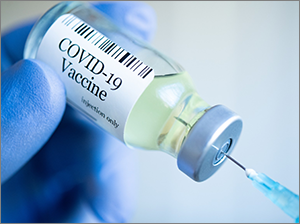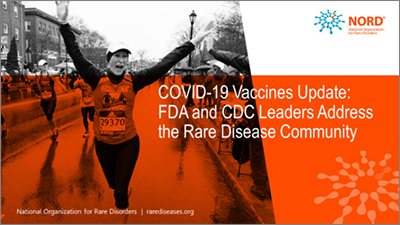COVID-19 VACCINE AND CMT Q&A*
[This page last updated on 5/25/2021.]
What are the side effects of the COVID vaccine? Will they affect my CMT?

The known side effects of current and likely-to-be authorized COVID-19 vaccines are similar to those of the annual influenza vaccine. These include symptoms such as: muscle soreness at the injection site, fever, tiredness, body aches and headache.
Please consult with your physician regarding your personal medical history as it relates to vaccinations and the possibility of side effects of a COVID-19 vaccine for you.
What impacts will the vaccine have on possible future gene therapy treatments or medications?
Whether the vaccine will have an adverse impact on any course of treatment that you or your loved one may be taking is something that you will want to consult with your clinician about directly. Upon the FDA authorization of the Pfizer/BioNTech vaccine, the FDA did not name any contraindications pertaining to genetic therapies or other medications particularly important to the CMT community. Should there be any contraindications that accompany future Agency decisions, we will update our information accordingly. However, this question can best be addressed by your clinician.
For more general information about the COVID-19 vaccine that is updated regularly by the Centers for Disease Control and Prevention, please visit the CDC COVID-19 Vaccine FAQ page.
*Disclaimer: Nothing shared on this page should be construed or is intended to be used for medical diagnosis or treatment. It should not be used in place of the advice of your physician or other qualified health care provider. Should you have any emergency questions or concerns, please contact your physician or health care provider immediately. Always consult with your physician or other health care provider to gain clarification regarding any health care related questions. This content was sourced from the CDC, the CMTA Scientific Advisory Board, the MDA and the NY Times.
MORE ABOUT COVID-19 AND VACCINES

NORD hosted a very informative webinar with the FDA and the CDC on COVID-19 vaccines and the rare disease community.
The webinar provided several key takeaways and included discussion of the expedited clinical trials that resulted in FDA’s issuing EUAs for the Pfizer-BioNTech and Moderna vaccines, the vaccines’ high rates of effectiveness in combating COVID-19, as well as the imminent arrival of more vaccines, including a one dose option, that could drastically increase the ability to vaccinate the population quickly. Rare disease patients and caregivers were encouraged to get vaccinated as soon as possible, as many rare conditions put individuals at increased risk for severe outcomes from COVID-19.
To view the webinar, you will need to register/sign in here.
The Department of Health & Human Services (HHS), in coordination with NIH and Operation Warp Speed, has also launched a central web portal at (https://combatcovid.hhs.gov/) called Combat COVID. The portal is a one-stop resource to help members of the public and doctors find information about different stages of COVID-19 illness, NIH-supported COVID-19 prevention and treatment clinical trials, and locations to donate plasma. Also included is a video featuring Dr. Anthony Fauci explaining how vaccines work.
MORE ABOUT COVID-19 AND CMT
The CMTA is aware that the coronavirus (COVID-19) may have more of an impact on people and families who are at higher risk of infection, so we are reaching out to share resources and ensure you are informed.
Because CMT and neuromuscular diseases vary in severity from one person to the next, it is difficult to make recommendations across the board for everyone. And although CMT is not at this time specifically mentioned in the CDC’s list of medical conditions that may lead to someone being more likely to get severely ill from COVID-19, we do know that people with respiratory issues affected by CMT may be at higher risk of developing serious complications if infected.
Depending on your personal health and the situation in your local area, here is some information surrounding most frequently asked questions as well as information to keep in mind when putting a plan together for preventing and/or dealing with the Coronavirus:
What is Coronavirus and how is it spread?
COVID-19 is caused by a coronavirus called SARS-CoV-2. Coronaviruses are a large family of viruses that are common in people and may different species of animals, including camels, cattle, cats, and bats. Rarely, animal coronaviruses can infect people and then spread between people. This occurred with MERS-CoV and SARS-CoV, and now with the virus that causes COVID-19. The SARS-CoV-2 virus is a betacoronavirus, like MERS-CoV and SARS-CoV. All three of these viruses have their origins in bats. The sequences from U.S. patients are similar to the one that China initially posted, suggesting a likely single, recent emergence of this virus from an animal reservoir. However, the exact source of this virus is unknown.
The virus that causes COVID-19 is thought to spread mainly from person to person, mainly through respiratory droplets produced when an infected person coughs or sneezes. These droplets can land in the mouths or noses of people who are nearby or possibly be inhaled into the lungs. Spread is more likely when people are in close contact with one another (within about 6 feet).
COVID-19 seems to be spreading easily and sustainably in the community (“community spread”) in many affected geographic areas. Community spread means people have been infected with the virus in an area, including some who are not sure how or where they became infected.
What are symptoms of Coronavirus?
People with COVID-19 have had a wide range of symptoms reported – ranging from mild symptoms to severe illness. Symptoms may appear 2-14 days after exposure to the virus. People with these symptoms may have COVID-19:
- Cough
- Shortness of breath or difficulty breathing
- Fever
- Chills
- Muscle pain
- Sore throat
- New loss of taste or smell
Children have similar symptoms to adults and generally have mild illness.
This list is not all inclusive. Other less common symptoms have been reported, including gastrointestinal symptoms like nausea, vomiting, or diarrhea. Read about COVID-19 Symptoms.
What Should You Do if You’re Sick?
For neuromuscular disease patients, it is important that you seek prompt medical attention if you or anyone in your household is identified with symptoms consistent with COVID-19 or for documented exposure to an individual who has tested positive. Before seeking care, you should contact your healthcare provider and tell them that you have symptoms consistent with COVID-19 or have been exposed to someone who has or is being evaluated for COVID-19. It is important to notify your healthcare provider of your symptoms and potential exposure prior to entering a healthcare provider’s office to ensure proper precautions can be taken to help keep other people in the office or waiting room from getting infected or exposed.
Contact your healthcare provider or health department to see if you should be tested. Your healthcare provider will provide guidance for having your symptoms evaluated and monitored.
If you have a medical emergency and need to call 911, notify the dispatch personnel that you or a member of your household has, or is being evaluated for SARS-CoV-2. You should go to an Emergency Room or Urgent Care facility if you are having shortness of breath or experiencing worsening symptoms. It is important that you call ahead to the facility and notify them if you or a member of your household has or is being evaluated for SARS-CoV-2.
The CDC has developed guidelines to prevent the spread of COVID-19 if you are sick.
How Can You Prevent the Virus from Affecting You or Your Family?
There is currently no preventative vaccine or specific treatment for COVID-19. The best way to prevent illness is to avoid being exposed to the virus. However, as a reminder, CDC always recommends everyday preventive actions to help prevent the spread of respiratory diseases, including:
Know how it spreads
- There is currently no vaccine to prevent coronavirus disease 2019 (COVID-19).
- The best way to prevent illness is to avoid being exposed to this virus.
- The virus is thought to spread mainly from person-to-person.
- Between people who are in close contact with one another (within about 6 feet).
- Through respiratory droplets produced when an infected person coughs, sneezes or talks.
- These droplets can land in the mouths or noses of people who are nearby or possibly be inhaled into the lungs.
- Some recent studies have suggested that COVID-19 may be spread by people who are not showing symptoms.
Wash your hands often
- Wash your hands often with soap and water for at least 20 seconds especially after you have been in a public place, or after blowing your nose, coughing, or sneezing.
- If soap and water are not readily available, use a hand sanitizer that contains at least 60% alcohol. Cover all surfaces of your hands and rub them together until they feel dry.
- Avoid touching your eyes, nose, and mouth with unwashed hands.
Avoid close contact
- Avoid close contact with people who are sick, even inside your home. If possible, maintain 6 feet between the person who is sick and other household members.
- Put distance between yourself and other people outside of your home.
- Remember that some people without symptoms may be able to spread virus.
- Stay at least 6 feet (about 2 arms’ length) from other people.
- Do not gather in groups.
- Stay out of crowded places and avoid mass gatherings.
- Keeping distance from others is especially important for people who are at higher risk of getting very sick.
Cover your mouth and nose with a cloth face cover when around others
- You could spread COVID-19 to others even if you do not feel sick.
- Everyone should wear a cloth face cover when they have to go out in public, for example to the grocery store or to pick up other necessities. (Cloth face coverings should not be placed on young children under age 2, anyone who has trouble breathing, or is unconscious, incapacitated or otherwise unable to remove the mask without assistance.)
- The cloth face cover is meant to protect other people in case you are infected.
- Do NOT use a facemask meant for a healthcare worker.
- Continue to keep about 6 feet between yourself and others. The cloth face cover is not a substitute for social distancing.
Cover coughs and sneezes
- If you are in a private setting and do not have on your cloth face covering, remember to always cover your mouth and nose with a tissue when you cough or sneeze or use the inside of your elbow.
- Throw used tissues in the trash.
- Immediately wash your hands with soap and water for at least 20 seconds. If soap and water are not readily available, clean your hands with a hand sanitizer that contains at least 60% alcohol.
- Clean AND disinfect frequently touched surfaces daily. This includes tables, doorknobs, light switches, countertops, handles, desks, phones, keyboards, toilets, faucets, and sinks.
- If surfaces are dirty, clean them. Use detergent or soap and water prior to disinfection.
- Then, use a household disinfectant. Most products with the common EPA-registered household disinfectantsexternal icon will work.





